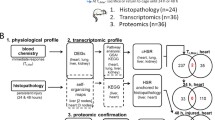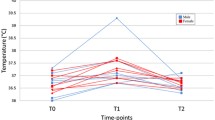Abstract
The gene expression changes produced by moderate hypothermia are not fully known, but appear to differ in important ways from those produced by heat shock. We examined the gene expression changes produced by moderate hypothermia and tested the hypothesis that rewarming after hypothermia approximates a heat-shock response. Six sets of human HepG2 hepatocytes were subjected to moderate hypothermia (31°C for 16 h), a conventional in vitro heat shock (43°C for 30 min) or control conditions (37°C), then harvested immediately or allowed to recover for 3 h at 37°C. Expression analysis was performed with Affymetrix U133A gene chips, using analysis of variance-based techniques. Moderate hypothermia led to distinct time-dependent expression changes, as did heat shock. Hypothermia initially caused statistically significant, greater than or equal to twofold changes in expression (relative to controls) of 409 sequences (143 increased and 266 decreased), whereas heat shock affected 71 (35 increased and 36 decreased). After 3 h of recovery, 192 sequences (83 increased, 109 decreased) were affected by hypothermia and 231 (146 increased, 85 decreased) by heat shock. Expression of many heat shock proteins was decreased by hypothermia but significantly increased after rewarming. A comparison of sequences affected by thermal stress without regard to the magnitude of change revealed that the overlap between heat and cold stress was greater after 3 h of recovery than immediately following thermal stress. Thus, while some overlap occurs (particularly after rewarming), moderate hypothermia produces extensive, time-dependent gene expression changes in HepG2 cells that differ in important ways from those induced by heat shock.







Similar content being viewed by others
Notes
The figure thus does not include DNAJA3, whose largest significant change in expression was a decrease in expression of 0.75-fold relative to control at the T = 3 time point.
References
Ashburner M, Ball CA, Blake JA, Botstein D, Butler H, Cherry JM, Davis AP, Dolinski K, Dwight SS, Eppig JT, Harris MA, Hill DP, Issel-Tarver L, Kasarskis A, Lewis S, Matese JC, Richardson JE, Ringwald M, Rubin GM, Sherlock G (2000) Gene ontology: tool for the unification of biology. The Gene Ontology Consortium. Nat Genet 25:25–29
Bernard SA, Gray TW, Buist MD, Jones BM, Silvester W, Gutteridge G, Smith K (2002) Treatment of comatose survivors of out-of-hospital cardiac arrest with induced hypothermia. N Engl J Med 346:557–563
Boss O, Samec S, Dulloo A, Seydoux J, Muzzin P, Giacobino JP (1997) Tissue-dependent upregulation of rat uncoupling protein-2 expression in response to fasting or cold. FEBS Lett 412:111–114
Cotto JJ, Morimoto RI (1999) Stress-induced activation of the heat-shock response: cell and molecular biology of heat-shock factors. Biochem Soc Symp 64:105–118
Danno S, Nishiyama H, Higashitsuji H, Yokoi H, Xue JH, Itoh K, Matsuda T, Fujita J (1997) Increased transcript level of RBM3, a member of the glycine-rich RNA-binding protein family, in human cells in response to cold stress. Biochem Biophys Res Commun 236:804–807
Denjean F, Lachuer J, Geloen A, Cohen-Adad F, Moulin C, Barre H, Duchamp C (1999) Differential regulation of uncoupling protein-1, -2 and -3 gene expression by sympathetic innervation in brown adipose tissue of thermoneutral or cold-exposed rats. FEBS Lett 444:181–185
Draghici S, Khatri P, Bhavsar P, Shah A, Krawetz SA, Tainsky MA (2003) Onto-tools, the toolkit of the modern biologist: onto-express, onto-compare, onto-design and onto-translate. Nucleic Acids Res 31:3775–3781
Farrell RE Jr (1998) Determination of nucleic acid concentration and purity. RNA methodologies. Academic, San Diego, pp 94–103
Fukui O, Kinugasa Y, Fukuda A, Fukuda H, Tskitishvili E, Hayashi S, Song M, Kanagawa T, Hosono T, Shimoya K, Murata Y (2006) Post-ischemic hypothermia reduced IL-18 expression and suppressed microglial activation in the immature brain. Brain Res 1121:35–45
Fuller BJ (2003) Gene expression in response to low temperatures in mammalian cells: a review of current ideas. Cryo Lett 24:95–102
Ganta CK, Helwig BG, Blecha F, Ganta RR, Cober R, Parimi S, Musch TI, Fels RJ, Kenney MJ (2006) Hypothermia-enhanced splenic cytokine gene expression is independent of the sympathetic nervous system. Am J Physiol Regul Integr Comp Physiol 291:R558–R565
Khatri P, Draghici S, Ostermeier GC, Krawetz SA (2002) Profiling gene expression using onto-express. Genomics 79:266–270
Khatri P, Chen D, Reifman J, Lilly CM, Sonna LA Software tool for analysis of variance of DNA microarray data. USARIEM Technical Report TR 07/05. 12-15-2006. Natick, MA, US Army Research Institute of Environmental Medicine
Kobayashi MS, Asai S, Ishikawa K, Nishida Y, Nagata T, Takahashi Y (2008) Global profiling of influence of intra-ischemic brain temperature on gene expression in rat brain. Brain Res Rev 58:171–191
Kregel KC (2002) Heat shock proteins: modifying factors in physiological stress responses and acquired thermotolerance. J Appl Physiol 92:2177–2186
Lindquist S (1986) The heat-shock response. Annu Rev Biochem 55:1151–1191
Marion DW, Penrod LE, Kelsey SF, Obrist WD, Kochanek PM, Palmer AM, Wisniewski SR, DeKosky ST (1997) Treatment of traumatic brain injury with moderate hypothermia. N Engl J Med 336(8):540–546
McIntyre LA, Fergusson DA, Hebert PC, Moher D, Hutchison JS (2003) Prolonged therapeutic hypothermia after traumatic brain injury in adults: a systematic review. JAMA 289:2992–2999
Mizuno T, Miura-Suzuki T, Yamashita H, Mori N (2000) Distinct regulation of brain mitochondrial carrier protein-1 and uncoupling protein-2 genes in the rat brain during cold exposure and aging. Biochem Biophys Res Commun 278:691–697
Niemann CU, Xu F, Choi S, Behrends M, Park Y, Hirose R, Maher JJ (2010) Short passive cooling protects rats during hepatectomy by inducing heat shock proteins and limiting the induction of pro-inflammatory cytokines. J Surg Res 158:43–52
Nishiyama H, Higashitsuji H, Yokoi H, Itoh K, Danno S, Matsuda T, Fujita J (1997a) Cloning and characterization of human CIRP (cold-inducible RNA-binding protein) cDNA and chromosomal assignment of the gene. Gene 204:115–120
Nishiyama H, Itoh K, Kaneko Y, Kishishita M, Yoshida O, Fujita J (1997b) A glycine-rich RNA-binding protein mediating cold-inducible suppression of mammalian cell growth. J Cell Biol 137:899–908
Ohta H, Terao Y, Shintani Y, Kiyota Y (2007) Therapeutic time window of post-ischemic mild hypothermia and the gene expression associated with the neuroprotection in rat focal cerebral ischemia. Neurosci Res 57:424–433
Parsell DA, Lindquist S (1993) The function of heat-shock proteins in stress tolerance: degradation and reactivation of damaged proteins. Annu Rev Genet 27:437–496
Remick DG, Xioa H (2006) Hypothermia and sepsis. Front Biosci 11:1006–1013
Safar PJ, Kochanek PM (2002) Therapeutic hypothermia after cardiac arrest. N Engl J Med 346:612–613
Sonna LA, Fujita J, Gaffin SL, Lilly CM (2002a) Invited review: effects of heat and cold stress on mammalian gene expression. J Appl Physiol 92:1725–1742
Sonna LA, Gaffin SL, Pratt RE, Cullivan ML, Angel KC, Lilly CM (2002b) Effect of acute heat shock on gene expression by human peripheral blood mononuclear cells. J Appl Physiol 92:2208–2220
Sonna LA, Cullivan ML, Sheldon HK, Pratt RE, Lilly CM (2003) Effect of hypoxia on gene expression by human hepatocytes (HepG2). Physiol Genomics 12:195–207
Sonna LA, Kuhlmeier MM, Carter HC, Hasday JD, Lilly CM, Fairchild KD (2006) Effect of moderate hypothermia on gene expression by THP-1 cells: a DNA microarray study. Physiol Genomics 26:91–98
Wood RJ, Tchack L, Angelo G, Pratt RE, Sonna LA (2004) DNA microarray analysis of vitamin D-induced gene expression in a human colon carcinoma cell line. Physiol Genomics 17:122–129
Yamashita H, Sato Y, Mori N (1999) Difference in induction of uncoupling protein genes in adipose tissues between young and old rats during cold exposure. FEBS Lett 458:157–161
Yenari MA, Han HS (2006) Influence of hypothermia on post-ischemic inflammation: role of nuclear factor kappa B (NFkappaB). Neurochem Int 49:164–169
Acknowledgments
The views, opinions, and findings contained in this publication are those of the authors and should not be construed as an official USUHS or US Department of the Army position, policy, or decision, unless so designated by other documentation.
Approved for public release; distribution unlimited.
Funding was provided by the US Army Medical Research and Materiel Command (USAMRMC). National Heart, Lung, and Blood Institute Grants HL-64104 and HL-072114 also supported this work.
The authors thank Dr. Michael Sawka of the US Army Research Institute of Environmental Medicine, Natick, MA, USA and Dr. Karen Fairchild of the University of Virginia, Charlottesville, VA, USA for critical review of this manuscript. The authors would also like to thank Dr. Jaques Reifman, whose input contributed to the development of the software used to analyze these data.
Author information
Authors and Affiliations
Corresponding author
Electronic supplementary material
Below is the link to the electronic supplementary material.
ESM 1
(DOC 502 kb)
Rights and permissions
About this article
Cite this article
Sonna, L.A., Kuhlmeier, M.M., Khatri, P. et al. A microarray analysis of the effects of moderate hypothermia and rewarming on gene expression by human hepatocytes (HepG2). Cell Stress and Chaperones 15, 687–702 (2010). https://doi.org/10.1007/s12192-010-0181-2
Received:
Revised:
Accepted:
Published:
Issue Date:
DOI: https://doi.org/10.1007/s12192-010-0181-2




